
Our first stop after leaving Jacksonville to cruise up the St. Johns River was Doctors Lake – only 12 nautical miles up stream.
We figured this would be a good short first hop to get back into the groove of living on the water, and we had heard that you could dinghy ashore at Whitey’s Fish Camp for an authentic old-Florida experience and a fabulous dinner.
We were downright excited – thinking that a classic Fish Camp would be the perfect transitions from the urban bustle of Jacksonville into the chill vibe of the river.
We almost made it. The photo above unfortunately was the last one we’d take with our Suzuki engine.
First, the video version of this story (with some awesome drone footage too!)
Row, Row, Row Your Boat…
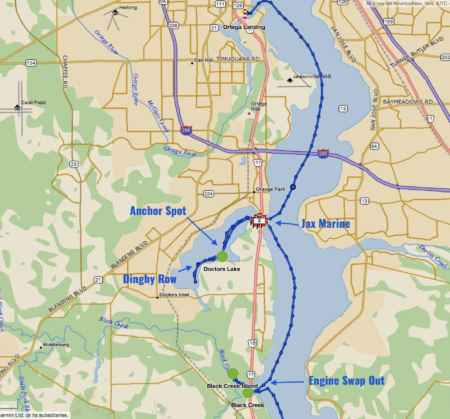
We anchored near the eastern shore of Doctors Lake, in a beautiful tranquil spot that seemed perfect for the night. The creek to Whitey’s was two miles away.
We first topped up our fuel tank from a jerry can we had filled a couple months ago in New Smyrna Beach, dropped the dinghy and set off for a fast jaunt across the glassy calm lake.
As we reached the creek entrance, just as Whitey’s docks were coming into view, we slowed down and dropped the dinghy off plane as we reached the no-wake zone.
At which point, the engine proceeded to sputter and die.
What!
Up until this moment, our Suzuki DF15AS2 engine had been perfectly reliable. It always started easy, usually with just a single pull. And it had never stalled even once. Until now.
Remembering we had just topped up the fuel supply, we immediately suspected bad fuel.
We tried to restart the engine, but it wouldn’t come to life for more than a few seconds, and eventually it wouldn’t even turn over at all.
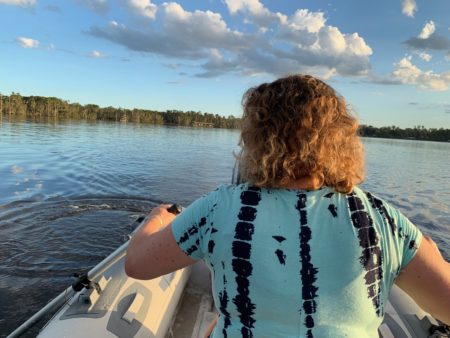
With the sun getting low on the horizon, we were left with no choice but to start rowing back towards Y-Not.
Needless to say, it took a LOT longer to get back – and we both took turns paddling, racing to stay ahead of the darkness and a line of storms.
On the plus side – the rowing workout actually felt great. And reminded us we need to shut the engine off more often and just row.
Troubleshooting at Dawn
It was dark by the time we reached home, so I deferred further troubleshooting until first thing in the morning.
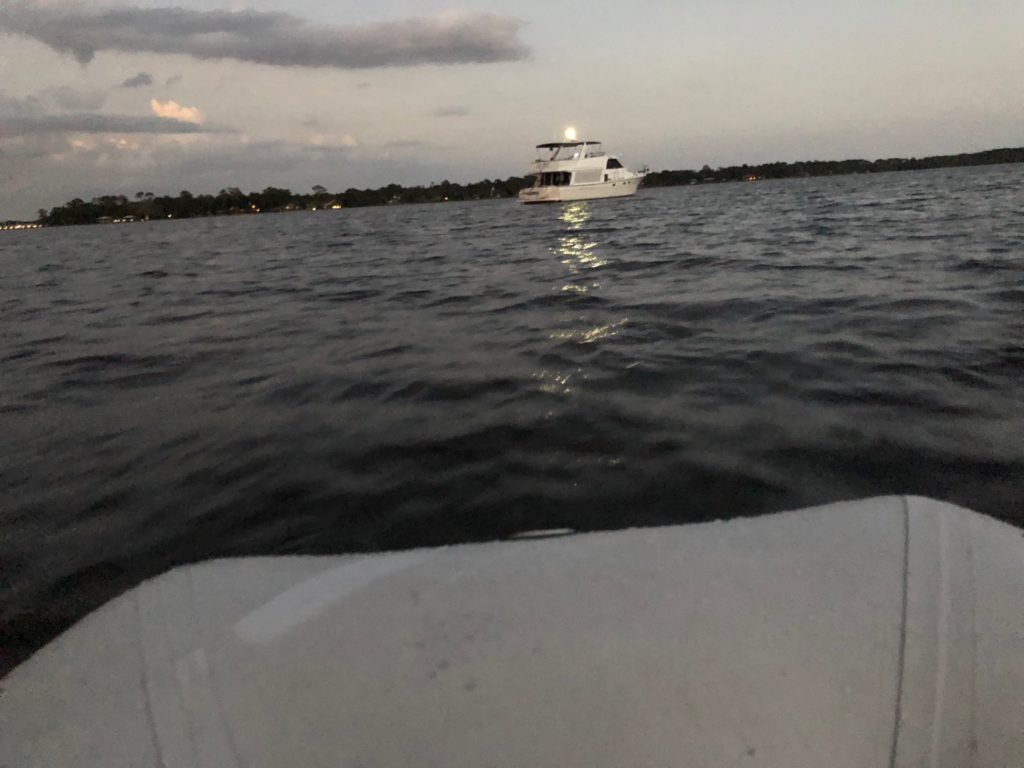
But poking around under the cowl in the early morning light didn’t reveal anything even slightly suspicious.
We were one day into our two week trip to Sanford, and our dinghy was effectively dead in the water.
This was not good.
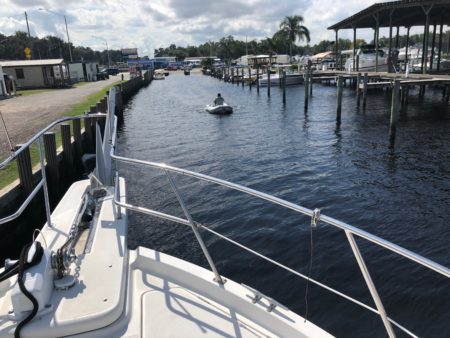
But fortunately, I checked the Suzuki website to try and find a dealer to call for help – and discovered that the nearest dealer was actually Jacksonville Marine, located on the water at Doctors Lake Marina just a mile away from where we were anchored.
Wow – what are the odds of that?
I called as soon as they opened, and they said they could look at our dinghy motor right away. They let us tie up Y-Not at the fuel dock, and I rowed over to the boat ramp and they hauled our dinghy off on a trailer for some troubleshooting.
We authorized an hour of troubleshooting time.
Hopefully something simple, right?
No Error Code, No Factory Assistance?!?
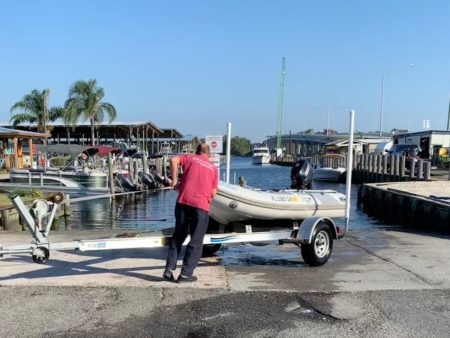
The mechanic at Jacksonville Marine called me after a few hours – frustrated.
He said that everything looked fine with the engine. Compression was good, there was a good spark, and they had tried starting off of their own fuel supply – and they couldn’t find anything wrong.
One of the mechanics even told me that “by all rights, that engine should start”.
But it was dead to them. So the next step was to try and get an error code off of the engine to find out what was going on.
If only it were that easy…
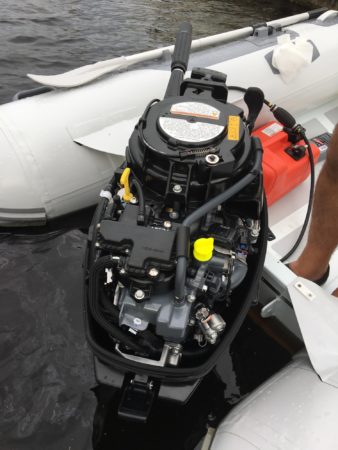
Suzuki is the only outboard manufacturer that builds small pull-start 15HP engines with electronic fuel injection instead of a carburetor. This supposedly offers up some fuel efficiency and environmental advantages, and makes the engine easier to start with no need for a choke.
But it also means that there is a small computer brain running the show.
And this small computer brain requires electric power to work – and since there is no battery, this power is actually generated by the very first rotation when the pull-start engages.
But when the engine isn’t running, the computer is dead. And if the computer is dead, there is no way for a diagnostic computer at the dealership to talk to it.
It turns out Suzuki has thought of this – and they have a special cable that can provide external power to the engine computer.
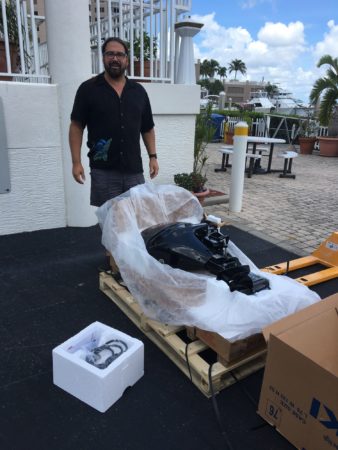
But without this cable, there was no way to talk to the engine. The mechanics at Jacksonville Marine called up their factory reps at Suzuki, and they were told they would get no troubleshooting assistance at all until they could provide an error code.
And that it would take a week to send over the necessary special diagnostic cable.
What?!!?
The folks at Jacksonville Marine were clearly embarrassed and extremely frustrated with Suzuki, and with me on the phone they started calling around to every other nearby Suzuki dealer trying to find some local help.
Most of them had never even heard of this cable, and the one that had said he had only ever seen it once when a factory rep was visiting and had used it to help troubleshoot something.
Even if we had a way to take our engine to another dealer – none of them felt there was anything they would be able to do without waiting a week to order in a cable.
And that would only help them learn what was wrong. Who know’s what fix might then be involved?!?
I called Suzuki’s customer service line directly and asked for help – could they point us towards any dealer in the Jacksonville area that had the right tools to diagnose and fix our engine?
Suzuki told me “every dealer is required to have that cable” and that they would call me back with information on where to go next.
BTW – they didn’t call back for a week.
In the meantime, we were very literally up a creek with only paddles.
Plan B: Yamaha?!?
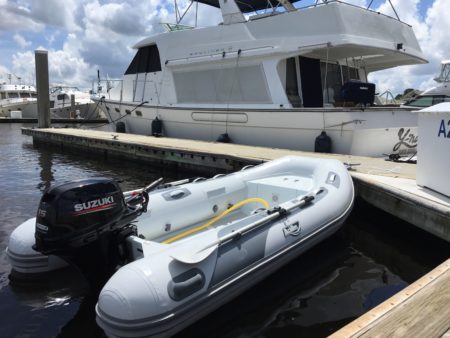
Jacksonville Marine apologized profusely, blamed Suzuki for offering them rotten support, and refused to charge us the pre-authorized diagnostic fee.
They had spent hours hitting a dead end, and told us there was nothing further they could do for us.
Realizing that Suzuki just didn’t have their act together enough to properly provide support for us as cruisers, Cherie was already leaning towards switching our focus away from fixing this engine – and pursuing trading in for one of a different brand.
We just didn’t want to spend our limited remaining cruising season this year waiting around for someone who could diagnose the engine. There was over a 100 miles ahead of St. Johns River to explore by both Y-Not and our dinghy.
So I asked the mechanics – what would you do?
They replied – “Honestly, I’d get a Yamaha.”
It seemed like an extreme solution – but even if we got this engine fixed, we just couldn’t trust that in the future we might not run into a dead-end like this again with Suzuki.
So I started calling around, trying to find where we could get a replacement engine (Jacksonville Marine didn’t have any of this size in stock) – ideally without delaying our cruising plans too much further.
Isle of Palms – Engine Swap
It was already Thursday afternoon, and Doctors Lake Marina where Jacksonville Marine is located was kind enough to let us stay on their fuel dock while we figured things out.
I called Isle of Palms Marine Service in Green Cove Springs a bit further up the river, and explained what we were looking for. They told us they had in stock and ready to go a new 15HP electric start Yamaha, a small 4HP Yamaha, and a gently-used 9.9HP pull-start Yamaha.
And even better – they told us they could actually handle getting our Suzuki engine repaired (hopefully under warranty) and they would take in on consignment to sell.
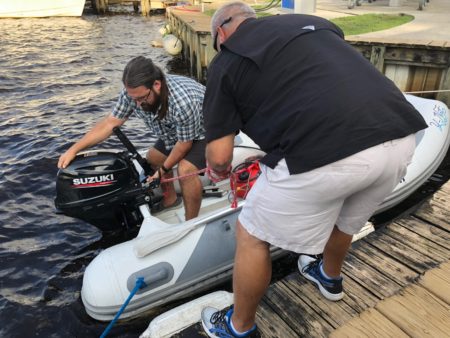
And best of all – they would meet us that afternoon at Black Creek Marina to drive us to their shop to work everything out.
Sweet – it looks like we could get this problem solved quickly!
Unfortunately Black Creek Marina had no slips available, but there was a nearby anchorage and they agreed to let us row ashore (fabulous friendly folks) and use their facilities for the swap.
Paul at Isle of Palms met us at the marina and helped us get the Suzuki off the dinghy and took us a mile up the road to the shop.
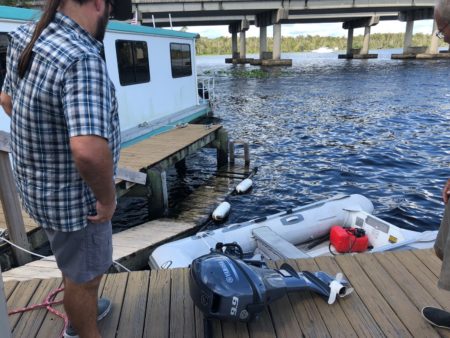
After weighing our options, we decided the used 9.9HP engine would be the best pick for us – subject to a test run to make sure that it was strong enough to get our dinghy up on plane with both of us aboard.
We made arrangements to meet again the next day – and they brought the Yamaha out to the dock and we swapped it in.
And – yay – it was plenty strong enough for us!
It too however stalled out on us on our test run, running off our fuel supply.
Isle of Palm brought down their mechanic Kyle, and he got it back running, suspecting it was either the fuel or the temporary fuel line they had hooked up.
We bought new non-ethanol gas at the marina and we’ve now been jetting around with the new engine for the past month, and so far it has been an overall improvement.
A few notes comparing it with our old 15HP Suzuki :
-
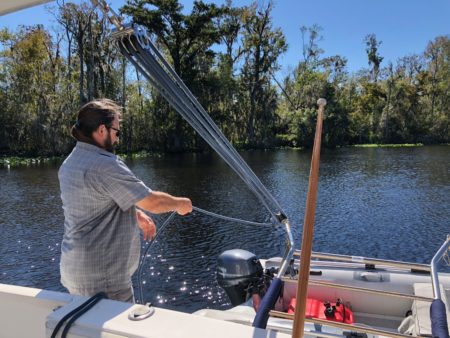
The new Yamaha matched our Achilles boat better, and is lighter for hoisting. 9.9HP Seems Plenty – We can definitely notice that it takes longer to get up on plane, but overall we can scoot along just fine. Cherie felt the old engine was a bit overpowered, and she is already more comfortable with the new one.
- More Comfortable to Drive – For whatever reason, there is less vibration in the tiller handle with the Yamaha than with the Suzuki. After a long trip, we often had numb hands with the Suzuki.
- It IS Harder to Start – It takes a longer and harder pull to start the Yamaha, and it usually takes multiple pulls when the engine is cold. The EFI Suzuki always started easy. We are already contemplating adding an electric start to make this easier, and fortunately this seems to be a simple upgrade.
- Lighter – The 9.9HP Yamaha is lighter than the 15HP Suzuki, which makes hoisting our dinghy davit a bit easier.
- It Looks Better – The grey Yamaha goes better with our Achilles dinghy than the black Suzuki. *grin*
Suzuki Follow Up & What Was Wrong?!?!
Suzuki Follow-Up
Suzuki corporate support eventually called back a full week later.
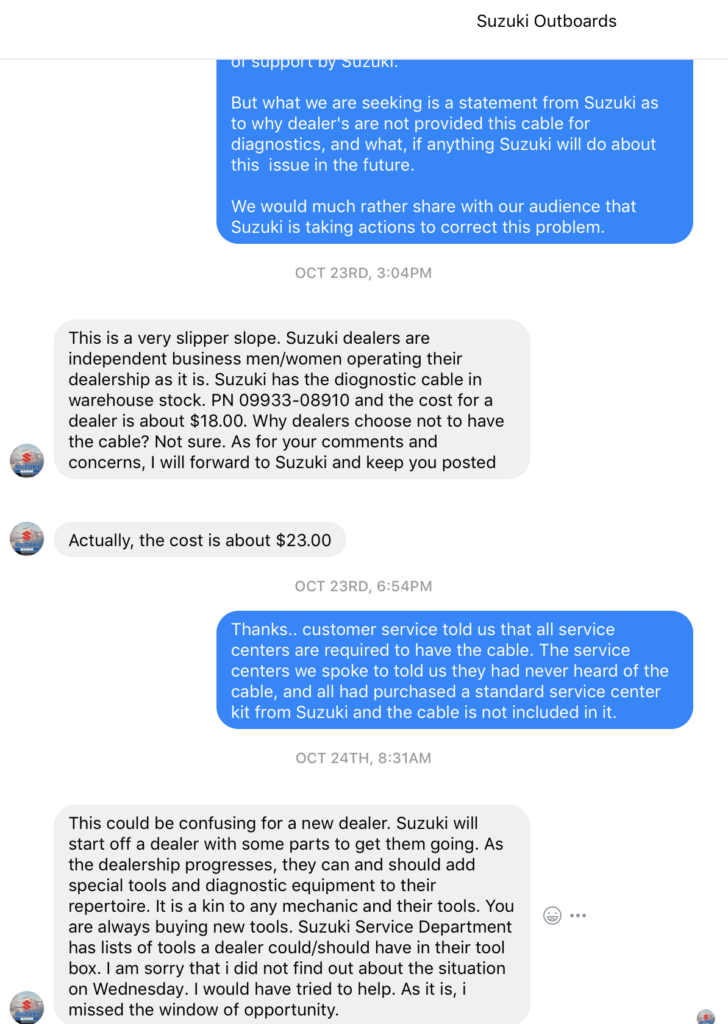
They said they had followed up with the District Service Manager, and he recommended we go to Advance Marine for service on our small outboard. Amusingly – Advance Marine was actually one of the local dealers that Jacksonville Marine had called, and they had told us that they did not have the magical cable and wouldn’t be able to help for at least a week.
If that is the best Suzuki can offer, and it takes them a week, there are clearly overall support issues that they need to work through.
Cherie also pursued Suzuki’s social media team via their Facebook Page. Despite customer service telling us that all dealers were required to have this cable – she was told that the basic dealer kit does NOT include the cable, and that dealer’s are expected to know to add speciality parts like this to their kit as their dealership grows.
Neither customer support or social media support seemed at all interested improving their dealer training on this issue.
What Was Wrong ?
Meanwhile – Isle of Palms let us know that they had been able to fix our engine, without needing the special cable.
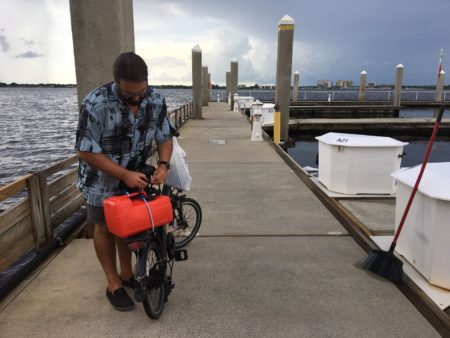
Because of the strongly suspected bad fuel, and though Jacksonville Marine had told us they had ruled fuel out as a problem – Isle of Palms went ahead and cleaned the injectors and spark plug and flushed the fuel system.
They tell us the engine is now running perfectly.
In hindsight – Jacksonville Marine should have been able to do the same thing. Especially since we had specifically mentioned we suspected bad fuel.
But I guess they were just too dependent on needing an error code and an official diagnosis to proceed and/or they had reached their frustration limit dealing with Suzuki support.
Sometimes there is a downside to advanced technology, and being too reliant on computers.
So in the end, the cause of the problem was our fuel supply – and not anything on Suzuki’s end, and nor would it be covered by warranty. We have no doubt Suzuki is a quality product. But the incident did reveal a potential hole in Suzuki’s support network that leaves us still feeling like we made the right decision to replace the engine and move on.
Anyway – our Suzuki DF15SA2 is still available for sale in consignment if anyone is looking for a great 15HP engine in the North Florida area. It still has a year and half of warranty left on it. Once the old engine sells, the entire transaction should be pretty much a wash for us.
Just know what you are getting into when it comes to getting support.
We’d recommend any cruiser with a Suzuki manual start outboard
pick up this cable so that you aren’t ever stuck:
Suzuki Part #: 0993308910 (Ebay link)
Maybe someday Suzuki will more pro-actively educate dealers on the importance of having this cable in their toolkit so that they’re not caught off guard when a customer with a problem needs service. Until then it might be a worthwhile $50 to spend.
All in all this was a relatively minor bump in the water, and we are pleased that we were able to handle it without interrupting our cruising plans much at all.
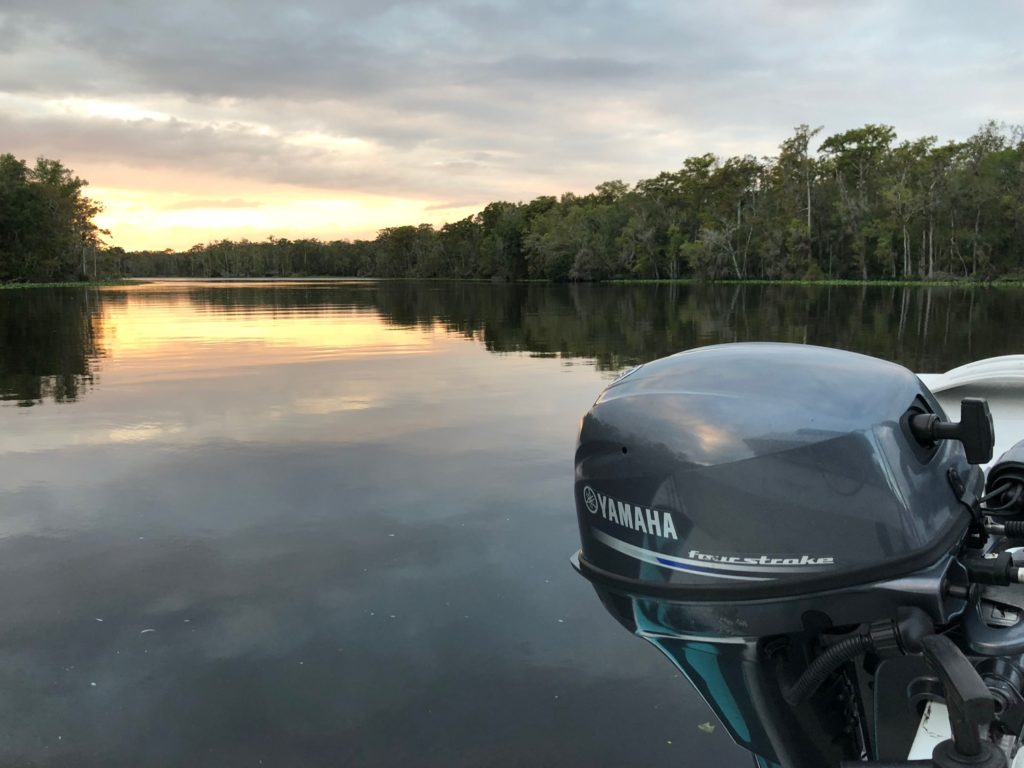
In fact, if it hadn’t been for needing to stop for the engine swap out, we might not have ended up anchored out in Black Creek for the weekend – which was one of the most beautiful stops along our entire river cruise!
We look forward to taking you along for our amazing St. Johns River cruise.. soon!

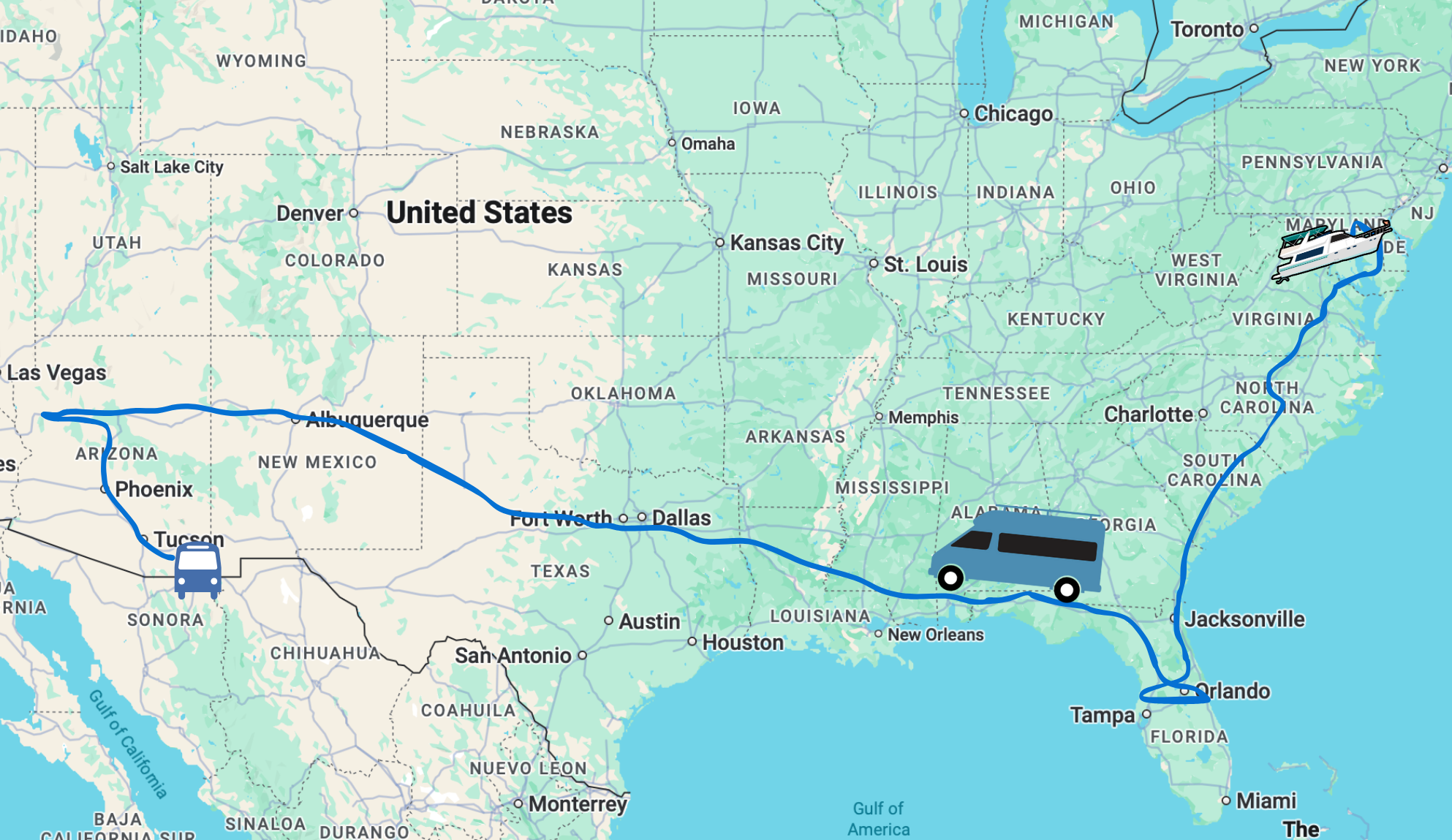
I am having issues with Suzuki and customer service too! I have a 2017 DF-4 (4hp) with less than 10 hours on it, and it has broken down three times. It’s the same issue, too. The exhaust valve gets stuck in the head and basically rusts itself open, leaving the engine with no compression. The past two times I brought it in, it was “fixed” under warranty, but then the same issue happens again after taking my boat out. It was fixed by two different shops. I thought the first shop didn’t fix it properly so I tried another shop. After it broke down a second time, I begun to suspect it was the product and not the service.
After the second “fix” didn’t work, I decided to call Suzuki customer service to explore my options. They basically told me to go kick rocks. They told me that they were honoring their warranty because they were repairing the issue (even though the root problem hasn’t been fixed). This is technically true, but anyone who stands by their product wouldn’t answer this way. I asked them what happens if I bring it in a third time and the issue occurs again. I got some canned answer of “we have to document and check with the service provider bla bla bla.”
Anyways, I brought it in for the third time yesterday and we will see.
Side notes: Yes, I am flushing my motor and treating it properly (fresh gas, 1/2 throttle because it’s still in break in period etc). I am also located in JAX. I’ll keep you updated on the progress of this.
Way too late now to be of any help, but from the video of the Yamaha running I would have to say you somehow got a tank or partial tank of Diesel for your dingy. This is somewhat confirmed by the report on the Suzuki engine (oily plug etc). As additives go, I have had good luck with Seafoam, while you should not really need it. Also check the info from Yamaha, it should be fine with ethanol blends. The problem with Ethanol on the older engines was seal (rubber) deterioration. Most newer engines use seals and hoses capable of running Ethanol blends. Cruise On, Kelvin
Chris the Seafoam works good to clean Carburetor and also injectors in 2 stroke DD engines. The newer gasoline’s are not so bad on new engines but are not great for old engines as our Bus engines. Not so much the Ethanol-blended gasoline but there is no longer top end lubrication in it and that is where the Seafoam comes in. With Ethanol fuels (Disagree with above) if you turn off the fuel supply and let it run out and stop then the next time you start it will be easy any small equipment is like that. Put a stabilizer in any you store for more than a few months. HTH
The local small engine repair guy in our little Montana town of Big Timber rants and raves EVERY time you go into his shop about storing gas. Wink (that’s his name) tells everyone they MUST have fresh gas–well when you live 22 miles from town on a ranch that’s a little impractical!!! My Cowboy thinks gas should be stored in metal containers and he does try to use it rapidly–but sometimes he has problems too–this fall it was our chain saws which wouldn’t start.
Thanks for the tale. I remembered you mentioning the beginning of this saga on a previous youtube video and was looking forward to finding out how it all turned out.
I don’t use stabilizer on fuel I’m planning to run through relatively quickly (maybe I should, but…?) I will put in Marine Sta-bil if I’m not using it very quickly (not saying there is anything special about Sta-bil as compared to others – I don’t know). Yamalube also makes a stabilizer.
If I’m leaving the engine for more than a couple/few weeks I drain the carbs (some fuel remains in the carb bowls even if you run the engine out of fuel and that can varnish and cause you to need new or rebuilt carbs). Just takes a couple of minutes, a screwdriver, and a bit of rag.
I do use Yamalube Ring Free in every tank (I have a Yamaha carbureted 4-stroke). This was recommended to me by the Yamaha dealer that did a big engine service after I bought my used engine – they seemed tidy and on the ball so I went with it. I have no idea if it’s snake oil or not, but it makes me feel organized and like I’m treating the engine well, so I do.
The Suzuki concept of EFI on a small, pull-start engine is nifty, but I agree that that particular combo fell through their cracks. I would have chosen the same remedy you did in your situation. Yamaha 9.9 is a classic and shouldn’t hold “mysteries” for the dealers even if something does go awry. Sure, your Suzuki didn’t really have a mechanical problem, but the need for the cord and Suzuki’s instant demand for a “code” probably threw the original place off track. I bet if it had been a “normal” engine they’d have caught on to the fuel issue without distraction (which ironically came from Suzuki!).
And the Facebook exchange was galling. Okay, so there was a problem. But now tell me what you are going to do to improve your procedures so it doesn’t happen to the next customer!
In every boat I have ever had and now in my gasoline for my generators, I add fuel stabilizer whenever I fuel up a tank. With fuel stabilizer in an outboard tank that was stored for 7 years when I hooked it up to the 15 horse Evinrude also stored for 7 years with no fuel draining, the motor started on the first pull. So a word to the wise, always stabilize your marine fuel. I would add that for the boat as well. You have been tied up for a month or more at various times. Modern fuels are not stable in any way shape or form. Recently I discovered that Seafoam is a better stabilizer than the newer versions of those too. The 7 year storage was with a product called Store and Start, which is no longer available. I have had short term success with Startron. Stabil has not worked even short term for me. So I have switched over to Seafoam. Time will tell how that works out. An advantage of Seafoam as a stabilizer is that it is a cleaner that works on all parts of an engine. Hope your new to you motor works out longer term.
On the bus we tend to toss in some Marvel Mystery Oil with every other diesel tank fill. We’ve had knowledgeable people tell us it is “useless snake oil, but harmless”, and we’ve had others swear by it. It certainly doesn’t hurt.
We haven’t picked out a stabilizer for our dinghy tank – and we probably should be treating our gas. But which one to use? Most seem to be advertised as to “reduce the harmful impact of Ethanol-blended gasoline”, but we’ve never let a drop of ethanol blended fuel into our engines.
I’ll give Sea Foam a try, unless someone suggests a better alternative.
Cheers!
– Chris
Glad you ended up with time in a beautiful area – but what a PITA! Boo to Suzuki.